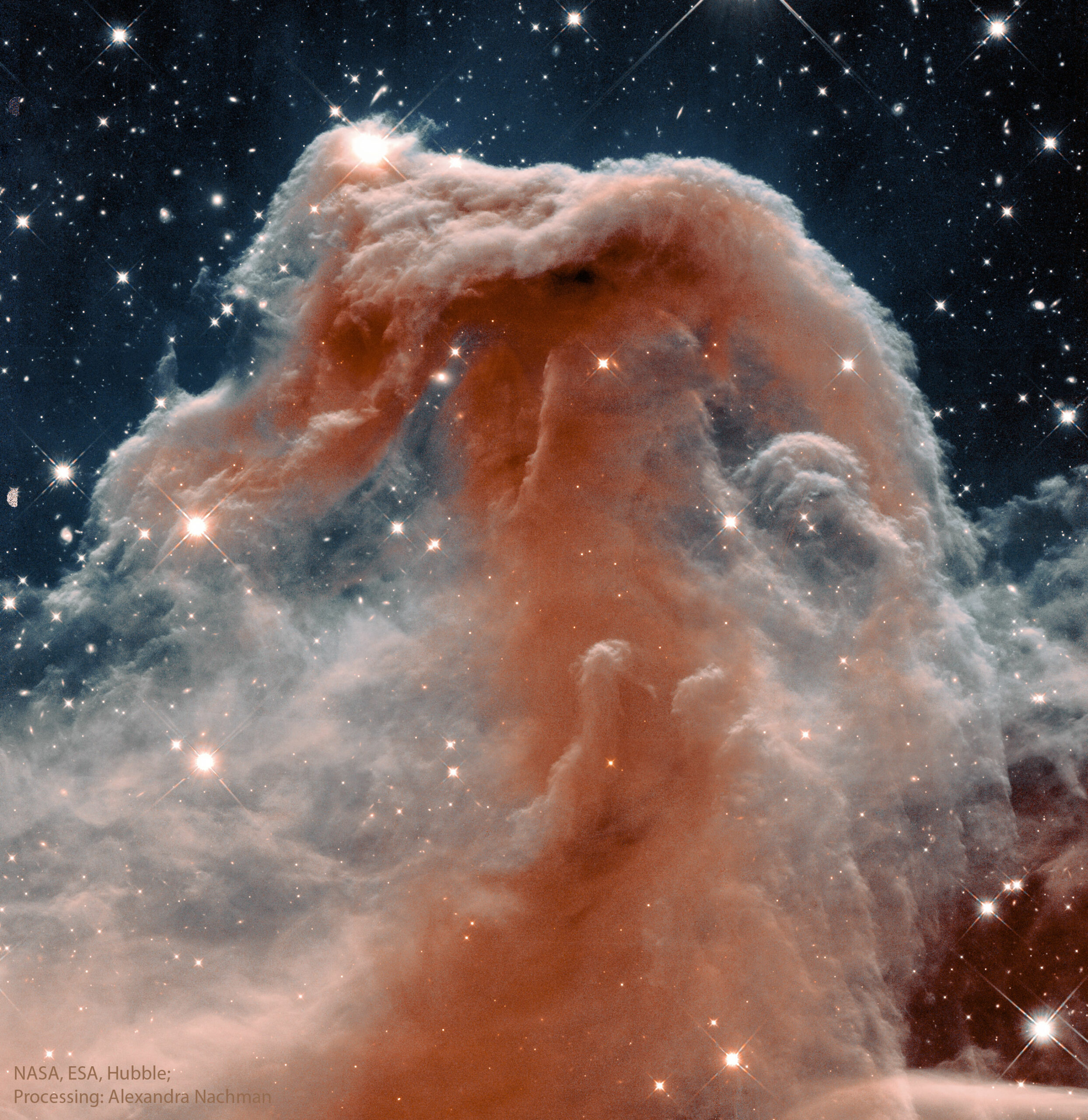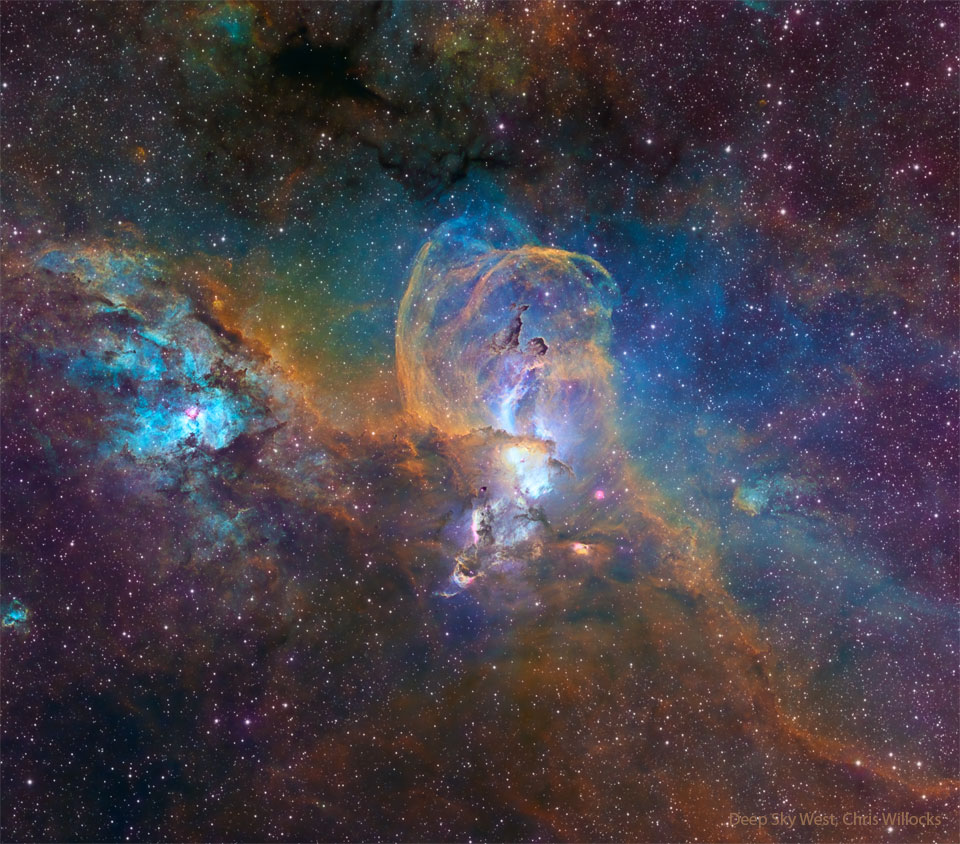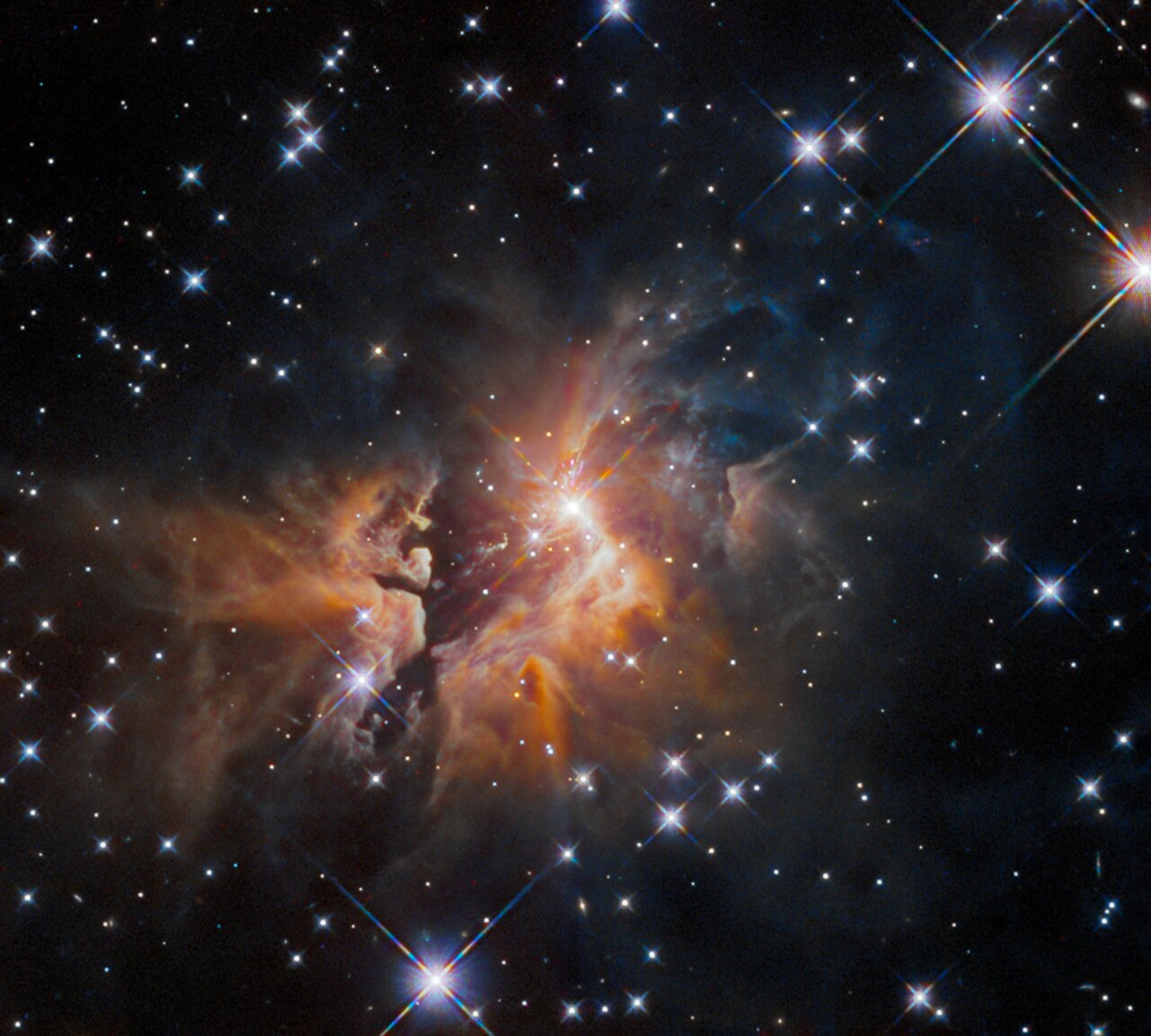Blog
While drifting through the cosmos, a magnificent interstellar dust cloud became sculpted by stellar winds and radiation to assume a recognizable shape. Fittingly named the Horsehead Nebula, it is embedded in the vast and complex Orion Nebula (M42). A potentially rewarding but difficult object to view personally with a small telescope, the featured gorgeously detailed image was taken in infrared light by the orbiting Hubble Space Telescope. The dark molecular cloud, roughly 1,500 light years distant, is cataloged as Barnard 33 and is seen above primarily because it is backlit by the nearby massive star Sigma Orionis. The Horsehead Nebula will slowly shift its apparent shape over the next few million years and will eventually be destroyed by high energy starlight.

Leonard Norman Cohen CC GOQ (September 21, 1934 – November 7, 2016) was a Canadian singer-songwriter, poet and novelist. His work explored religion, politics, isolation, depression, sexuality, loss, death, and romantic relationships. He was inducted into the Canadian Music Hall of Fame, the Canadian Songwriters Hall of Fame, and the Rock and Roll Hall of Fame. He was invested as a Companion of the Order of Canada, the nation’s highest civilian honour. In 2011, he received one of the Prince of Asturias Awards for literature and the ninth Glenn Gould Prize.
Cohen pursued a career as a poet and novelist during the 1950s and early 1960s, and did not begin a music career until 1967. His first album, Songs of Leonard Cohen (1967), was followed by three more albums of folk music: Songs from a Room (1969), Songs of Love and Hate (1971) and New Skin for the Old Ceremony(1974). His 1977 record Death of a Ladies’ Man, co-written and produced by Phil Spector, was a move away from Cohen’s previous minimalist sound.
In 1979, Cohen returned with the more traditional Recent Songs, which blended his acoustic style with jazz, East Asian, and Mediterranean influences. Cohen’s most famous song, “Hallelujah“, was released on his seventh album, Various Positions (1984). I’m Your Man in 1988 marked Cohen’s turn to synthesized productions. In 1992, Cohen released its follow-up, The Future, which had dark lyrics and references to political and social unrest.
Cohen returned to music in 2001 with the release of Ten New Songs, a major hit in Canada and Europe. His 11th album, Dear Heather, followed in 2004. In 2005, Cohen discovered that his manager had stolen most of his money and sold his publishing rights, prompting a return to touring to recoup his losses. Following a successful string of tours between 2008 and 2013, he released three albums in the final years of his life: Old Ideas (2012), Popular Problems (2014), and You Want It Darker (2016), the last of which was released three weeks before his death. A posthumous album, Thanks for the Dance, was released in November 2019, his fifteenth and final studio album.
more...James Marcellus Arthur “Sunny” Murray (September 21, 1936 – December 7, 2017) was one of the pioneers of the free jazz style of drumming.
Murray was born in Idabel, Oklahoma, where he was raised by an uncle who later died after being refused treatment at a hospital because of his race. He began playing drums at the age of nine. As a teen, he lived in a rough part of Philadelphia, and spent two years in a reformatory. In 1956, he moved to New York City, where he worked in a car wash and as a building superintendent. During this time, he played with musicians such as trumpeters Red Allen and Ted Curson, pianist Willie “The Lion” Smith, and saxophonists Rocky Boyd and Jackie McLean.
In 1959, he played for the first time with pianist Cecil Taylor and, according to Murray, “or six years all the other things were wiped from my mind…” “With Cecil, I had to originate a complete new direction on drums.” Murray stated: “We played for about a year, just practicing, studying — we went to workshops with Varèse, did a lot of creative things, just experimenting, without a job.” In 1961, Murray made a recording with Taylor’s group that was released under the auspices of Gil Evans as one side of Into the Hot.
more...
Charles Thomas Potter (September 21, 1918 – March 1, 1988) was an American jazz double bass player, best known for having been a member of Charlie Parker‘s “classic quintet”, with Miles Davis, between 1947 and 1950.
Born in Philadelphia, Pennsylvania, United States, Potter had first played with Parker in 1944, in Billy Eckstine‘s band with Dizzy Gillespie, Lucky Thompson and Art Blakey.
Potter also performed and recorded with many other notable jazz musicians, including Earl Hines, Artie Shaw, Bud Powell, Count Basie, Sonny Rollins, Stan Getz, Max Roach, Eddie Heywood, Tyree Glenn, Harry “Sweets” Edison, Buck Clayton and Charles Lloyd.
more...Leroy Eliot “Slam” Stewart (September 21, 1914 – December 10, 1987) was an American jazz double bass player, whose trademark style was his ability to bow the bass (arco) and simultaneously hum or sing an octave higher. He was a violinist before switching to bass at the age of 20. Stewart was born in Englewood, New Jersey, United States and began playing string bass while attending Dwight Morrow High School. While attending the Boston Conservatory, he heard Ray Perry singing along with his violin. This gave him the inspiration to follow suit with his bass. In 1937, Stewart teamed with Slim Gaillard to form the novelty jazz act Slim and Slam. The duo’s biggest hit was “Flat Foot Floogie (with a Floy Floy)” in 1938.
more...What’s happening in the Statue of Liberty nebula? Bright stars and interesting molecules are forming and being liberated. The complex nebula resides in the star forming region called RCW 57, and besides the iconic monument, to some looks like a flying superhero or a weeping angel. By digitally removing the stars, this re-assigned color image showcases dense knots of dark interstellar dust, fields of glowing hydrogen gasionized by these stars, and great loops of gas expelled by dying stars. A detailed study of NGC 3576, also known as NGC 3582 and NGC 3584, uncovered at least 33 massive stars in the end stages of formation, and the clear presence of the complex carbon molecules known as polycyclic aromatic hydrocarbons (PAHs). PAHs are thought to be created in the cooling gas of star forming regions, and their development in the Sun’s formation nebula five billion years ago may have been an important step in the development of life on Earth.

Keith Moore “Red” Mitchell (September 20, 1927 – November 8, 1992) was an American jazz double-bassist, composer, lyricist, and poet.
Mitchell was born in New York City. His younger brother, Whitey Mitchell, also became a jazz bassist.
Mitchell was raised in New Jersey by a father who was an engineer and loved music, and a mother who loved poetry. His first instruments were piano, alto saxophone, and clarinet. Although Cornell University awarded him an engineering scholarship, by 1947 he was in the U.S. Army playing bass. The next year, he was in a jazz trio in New York City.
Mitchell performed and/or recorded with Mundell Lowe, Chubby Jackson, Charlie Ventura, Woody Herman, Red Norvo, Gerry Mulligan, and, after joining the West Coast jazz scene in the early 1950s, with André Previn, Shelly Manne, Hampton Hawes, Billie Holiday, Stan Seltzer, Ornette Coleman, and others such as Mahalia Jackson. He also worked as a bassist in television and film studios around Los Angeles, occasionally appearing on screen. Mitchell also appeared in documentaries about Tal Farlow and Zoot Sims.
more...Eric Gale (September 20, 1938 – May 25, 1994) was an American jazz and R&B guitarist.
Born in Bedford–Stuyvesant, Brooklyn, New York, Gale grew up in a diverse household. His paternal grandfather was from Yorkshire, England. He had extended family in Barbados and Venezuela. Gale often visited the U.K. and Venezuela as an adolescent, which influenced his style into adulthood. He was fluent in Spanish.
Gale started playing the guitar at age 12. At that time, he skipped junior high school. Soon after, in high school, he visited John Coltrane‘s home after school and sat in on jam sessions, which inspired Gale’s readily recognizable style. Gale received his Master of Science in chemistry at Niagara University. He was also on the football team. Later, Gale was pursued by Frank Sinatra to work on the hit song “My Way”, as mentioned in Frank Sinatra’s autobiography. Gale decided to commit to a musical career full-time instead of getting his Ph.D. in Chemistry. Gale died of lung cancer in 1994 at the age of 55 and is survived by his wife Masako Murakami-Gale, their three daughters, and two grandchildren.
https://www.youtube.com/watch?v=JzkC6BCXmfA&t=583s
more...Foreststorn “Chico” Hamilton (September 20, 1921 – November 25, 2013) was an American jazz drummer and bandleader. He came to prominence as sideman for Lester Young, Gerry Mulligan, Count Basie, and Lena Horne. Hamilton became a bandleader, first with a quintet featuring the cello as a lead instrument, an unusual choice for a jazz band in the 1950s, and subsequently leading bands that performed cool jazz, post bop, and jazz fusion.
Foreststorn Hamilton was born in Los Angeles, California, one of three brothers, one of whom was actor Bernie Hamilton.
Hamilton started his career in a band with Charles Mingus, Illinois Jacquet, Ernie Royal, Dexter Gordon, Buddy Collette and Jack Kelso before he had finished high school. Engagements with Lionel Hampton, Slim & Slam, T-Bone Walker, Lester Young, Count Basie, Duke Ellington, Charlie Barnet, Billy Eckstine, Nat King Cole, Sammy Davis Jr., Billie Holiday, Gerry Mulligan and Lena Horne established his career.
more...Elvira “Vi” Redd (born September 20, 1928) is an American jazz alto saxophone player, vocalist and educator. She has been active since the early 1950s and is known primarily for playing in the blues style. She is highly regarded as an accomplished veteran who has performed with Count Basie, Rahsaan Roland Kirk, Linda Hopkins, Marian McPartland and Dizzy Gillespie.
Redd is the daughter of New Orleans jazz drummer and Clef Club co-founder Alton Redd and Mattie Redd (née Thomas). She was born in Los Angeles. She was deeply influenced during her formative years by her father, who was one of the leading figures on the Central Avenue jazz scene. Another important musical mentor was her paternal great aunt Alma Hightower.
more...
https://www.youtube.com/watch?v=tbPPfN4FvXM&list=PLEB3LPVcGcWZ0hsQ5_jgSMhawAnDzy1io&index=1
more...A bright young star is surrounded by a shroud of thick gas and dust in this image from the NASA/ESA Hubble Space Telescope. Hubble’s Wide Field Camera 3 inspected a young stellar object, over 9000 light years away in the constellation Taurus, to help astronomers understand the earliest stages in the lives of massive stars. This object — which is known to astronomers as IRAS 05506+2414 — is thought to be an example of an explosive event caused by the disruption of a massive young star system. If so, it would only be the second such example known. Usually the swirling discs of material surrounding a young star are funnelled into twin outflows of gas and dust from the star. In the case of IRAS 05506+2414, however, a fan-like spray of material travelling at velocities of up to 350 kilometres per second is spreading outwards from the centre of this image. Astronomers turned to Hubble’s Wide Field Camera 3 to measure the distance to IRAS 05506+2414. While it is possible to measure the velocity of material speeding outwards from the star, astronomers cannot tell how far from Earth the star actually is from a single observation. However, by measuring the distance that the outflow travels between successive images, they will be able to infer the distance to IRAS 05506+2414. This will allow astronomers to determine how bright the star is and how much energy it is emitting, and hence to estimate its mass — all vital information that will help to understand the origin of this bright young star’s unusual outflow.

Ellen Naomi Cohen (September 19, 1941 – July 29, 1974), known professionally as Cass Elliot, or Mama Cass, was an American singer and actress. She was a member of the singing group The Mamas & the Papas. After the group broke up, Elliot released five solo albums. In 1998, she was posthumously inducted into the Rock and Roll Hall of Fame for her work with The Mamas & the Papas.
Ellen Naomi Cohen was born in Baltimore, Maryland, on September 19, 1941, the daughter of Philip (died 1962) and Bess Cohen (née Levine; 1915–1994). All four of her grandparents were Russian Jewish immigrants. Her family was subject to significant financial stresses and uncertainties during her childhood years. Her father, involved in several business ventures, ultimately succeeded through the development of a lunch wagon in Baltimore that provided meals to construction workers.Her mother was a trained nurse. Elliot, age 32, died in her sleep at the London flat where she was staying. According to forensic pathologist Keith Simpson, who conducted her autopsy, her death was due to heart failure. “There was left-sided heart failure,” he wrote, “she had a heart attack which developed rapidly.”
more...Henry Kaiser (born September 19, 1952) is an American guitarist and composer, known as an idiosyncratic soloist, a sideman, an ethnomusicologist, and a film score composer. Recording and performing prolifically in many styles of music, Kaiser is a fixture on the San Francisco Bay Area music scene. He is considered a member of the “second generation” of American free improvisers. He is married to Canadian artist Brandy Gale. He is the son of Henry J. Kaiser Jr. and the grandson of industrialist Henry J. Kaiser.
In 1977, Kaiser founded Metalanguage Records with Larry Ochs (Rova Saxophone Quartet) and Greg Goodman. In 1979 he recorded With Friends Like These with Fred Frith, a collaboration which continued over the next 20 years. In 1983 they recorded Who Needs Enemies, and in 1987 the compilation album With Enemies Like These, Who Needs Friends? They joined with fellow experimental musicians John French, and English folk-rocker Richard Thompson to form French Frith Kaiser Thompson for two eclectic albums, Live, Love, Larf & Loaf (1987) and Invisible Means (1990). In 1999 Frith and Kaiser released Friends & Enemies, a compilation of their two Metalanguage albums along with additional material from 1984 and 1999.
more...George Lowen Coxhill (19 September 1932 – 10 July 2012) known professionally as Lol Coxhill, was an English free improvising saxophonist. He played soprano and sopranino saxophone.
Coxhill was born to George Compton Coxhill and Mabel Margaret Coxhill (née Motton) at Portsmouth, Hampshire, UK. He grew up in Aylesbury, Buckinghamshire, and bought his first saxophone in 1947. After national service he became a busy semi-professional musician, touring US airbases with Denzil Bailey’s Afro-Cubists and the Graham Fleming Combo. In the 1960s he played with visiting American blues, soul and jazz musicians including Rufus Thomas, Mose Allison, Otis Spann, and Champion Jack Dupree. He also developed his practice of playing unaccompanied solo saxophone, often busking in informal performance situations. Other than his solo playing, he performed mostly as a sideman or as an equal collaborator, rather than a conventional leader – there was no regular Lol Coxhill Trio or Quartet as would normally be expected of a saxophonist. Instead he had many intermittent but long-lasting collaborations with like-minded musicians.
more...Muhal Richard Abrams (born Richard Lewis Abrams; September 19, 1930 – October 29, 2017) was an American educator, administrator, composer, arranger, clarinetist, cellist, and jazz pianist in the free jazz medium. He recorded and toured the United States, Canada and Europe with his orchestra, sextet, quartet, duo and as a solo pianist. His musical affiliations constitute a “who’s who” of the jazz world, including Max Roach, Dexter Gordon, Eddie “Lockjaw” Davis, Art Farmer, Sonny Stitt, Anthony Braxton, and The Art Ensemble of Chicago.
Abrams’s mother, Edna, was born in Memphis. His father, Milton, was born in Alabama and moved with his parents to Chicago. Richard Lewis Abrams was born there, the second of nine children, on September 19, 1930. His father became a self-employed handyman; his mother was a housewife. “Abrams’s paternal grandfather was ‘what you call a junk man’, selling the fruits of neighborhood foraging. Abrams and his brother would pull the cart around the neighborhood, eventually arriving at a junk-yard on State Street, where the items would be sold.” Abrams first attended Forrestville public school in Chicago. He grew up in a gang area; truancy and fighting meant that he was sent to Moseley School, a reformatory school for boys. There, in addition to strict discipline, he was taught about black histories. He later moved on to DuSable High School. Although he was aware of the strong music program there, led by Walter Dyett, Abrams preferred playing sports, so did not participate in Dyett’s classes. Among the future musicians Abrams met at the school were Charles Davis, Richard Davis, John Gilmore, Johnny Griffin, Laurdine Patrick, and Julian Priester.
more...More Posts
- The Cosmos with M16
- Eric Dolphy Day
- Lazy Lester Day
- World Music with Obo Addy
- Daily Roots with Bob Marley
- The Cosmos with Fleming 1
- Ernest Ranglin Day
- Billy Drummond Day
- World Music with Lela Tataraidze
- Daily Roots with the Skatalites
- The Cosmos with NGC 6872 & IC 4970
- Paul McCartney Day
- William Hooker Day
- Rudy Rutherford Day
- World Fusion with Manika Kaur
- Daily Roots with the Congos
- Happy Fathers Day 2018
- The Cosmos with RCW 108
- Chuck Rainey Day
- Sing Miller Day